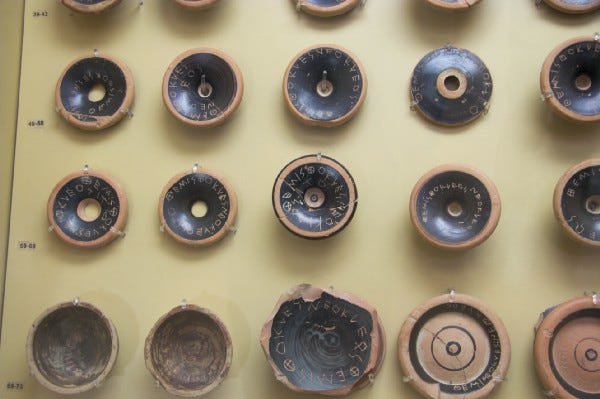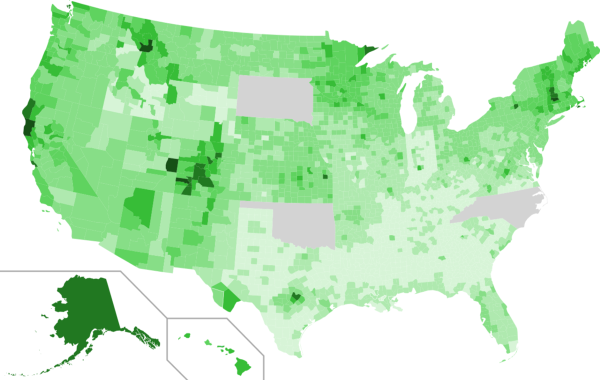A voting system in profile
One of the most common voting systems in use is the plurality vote. Plurality votes play a key role in most modern democracies. When there are more than two options, however, a plurality vote is deeply flawed. Most notably, a plurality vote with multiple candidates is highly vulnerable to spoiler effects, “center squeeze” effects, and can elect candidates who would lose against any other candidate in a head-to-head contest.

Plurality voting is nevertheless widespread, and has been around for a very long time. For example, the classical Athenian practice of ostracism was carried out using a plurality vote. Each voter scratched the name of the person they wished to ostracize onto a piece of pottery, or ostrakon. Provided that the number of votes met a certain minimum quorum, the person named on the most shards was then exiled. The fact that plurality voting has been around for a very long time is a point in its favor: Most voters understand how it works, and many people also understand how to try to work around its flaws.
Plurality voting defined
Most people understand the basic mechanics of how plurality voting works. To fully understand how plurality voting works and why it has problems, I will define plurality voting three times:
Plurality voting is a system of voting where each voter…
…may declare their allegiance to a candidate. For each voter pledging allegiance to a candidate, that candidate gains one point.
…may rank a set of candidates. For each first place ranking on a ballot, a candidate gains one point.
…evaluates a set of candidates, and may choose one candidate to approve. For each voter approving of them, a candidate gains one point.
The results are then based on which candidates have the most points. The candidate with the most points finishes in first place; if it matters, the candidate with the second-most points finishes in second place, and so on and so forth.
Plurality voting as a declaration of allegiance
On a basic level, I think this definition shows how plurality voting can be a very sociologically natural way of choosing a leader. In choosing the paramount leader for a collection of groups, it makes sense to select the leader who has the most followers.

For a group assembled in one place, it’s possible to carry out a plurality vote without any ballots at all. Voters stand in separate groups showing which candidate they support — then count snouts once everyone is done walking around. A variation of this technique is used in the Iowa caucuses.
Plurality voting as a ranked method
This is the definition of plurality voting most often used formally in voting theory. Arrow’s theorem, for example, defines a voting method as a way of translating from rankings by voters to rankings of candidates. Framed this way, there’s an obvious deficiency in plurality voting: It only considers first place preferences. There is no difference between someone’s second choice and their last choice.
Plurality voting as a “choose one” method
Why not allow voters to choose two candidates, or three? Why shouldn’t voters provide a rating for every candidate? Many local elections allow voters to choose multiple candidates in the same election when there are multiple seats to fill.
In 1796, most of Pennsylvania’s voters voted for fifteen out of thirty candidates for presidential elector, with interesting results. For that matter, the the original version of the Electoral College was a “vote for two” system, with each elector voting for up to two candidates. Approval voting allows voters to vote for as many candidates as they like; other similar rating systems allow voters to rate each candidate on their own merits.
What happens when you only count first place
The most common ways that elections go wrong are through spoiler effects and strategic voting. Plurality is exceptionally vulnerable to both of these, and also has a “center squeeze” problem.
Spoiler effects

In 2000, Ralph Nader, the Green Party candidate for president of the United States, earned about 5% of the total national vote.
The Greens are an environmentalist party. The Democratic candidate, Al Gore, was notable for his environmental activism, while the Republican candidate, George W. Bush, was a Texas oilman notable for his ties to oil companies. It is very likely that a large majority of Green Party voters preferred Gore to Bush. If those second place preferences had been counted thanks to the use of an alternate voting method, or if Nader simply had not been on the ballot in Florida, Gore would have won the presidential election.
Nader “spoiled” the 2000 election. Plurality voting is exceptionally vulnerable to spoiler effects, because plurality ballots only allow voters to express an opinion about a single candidate. Plurality voting outcomes are routinely decided by spoiler effects. The most famous US presidential “spoiler” candidates were outside of the political mainstream, including both Ralph Nader in 2000 and James G. Birney in 1844, but “spoiler” candidates can also come from the center.
Center squeeze
The best way to illustrate a center squeeze is with a diagram. Suppose there are three candidates distributed perfectly evenly across the political spectrum, at the 25th, 50th, and 75th percentiles of public opinion. What happens in a plurality vote?
If every voter chooses the candidate whose position is closest to theirs, the moderate candidate will earn 25% of the vote, while the left and right wing candidates each receive 37.5% of the vote. While the middle candidate has an advantage in a simple majority vote, a three-way plurality election “squeezes” center candidates, making them less viable.
In a plurality vote, a “spoiler” candidate earning a small share of the vote does not have to come from the political fringe. They can just as easily come from the political center — and they could be a superior candidate who would win a majority vote against any one of their opponents by themselves, in spite of their poor performance in a multi-candidate contest. Similarly, it’s possible for a plurality vote to elect a candidate who would never be able to win a majority vote. (These types of candidates are known as Condorcet winners and Condorcet losers.)
Strategic voting and Duverger’s law
This is assuming that voters vote for the candidate they most prefer. However, in a three-candidate plurality race with public opinion polling, voters whose first choice is the third-place candidate have an incentive to switch their support to one of the top-two candidates — because the third-place candidate is a non-viable spoiler.
This is a self-accelerating process. As more voters decide that a candidate seems non-viable, polls show fewer voters supporting that candidate — which makes them appear less viable. Strategic voting under plurality tends to collapse to the two candidates seen as most viable.
There is a related tendency of “first past the post” plurality voting systems to lead to two party systems, known as Durverger’s law. This tendency isn’t universally observed in political systems. Even in theoretical terms, the number of parties should be linked to the complexity of the political spectrum, because not all voters care about all issues.
How to vote better
To a large degree, the field of voting theory exists because plurality voting is deeply flawed. When Jean Charles de Borda introduced the Borda count to the French Academy of Science in 1770, he did it because he could clearly see the types of deficiencies I’ve described above.
Within voting theory, the way to criticize a voting system strongly is to say that it is even worse than plurality. Plurality voting is the gold standard for a bad voting system, in other words. Alternatives to plurality voting, such as approval voting, ranked choice voting, STAR voting, et cetera generally make use of more information; voters will either rank or rate multiple candidates.

Alternative voting methods requiring rating or ranking multiple candidates have rarely been implemented, however. One reason for this is that the ballots are slightly more complex. There are two major ways to mitigate the problems with plurality voting.
First, always require a majority. If no candidate earns a majority, require a runoff between the top two candidates. Plurality with majority runoff does not avoid all the flaws of a plurality vote, but it avoids the worst case scenarios where one deeply unpopular candidate manages to eke out a win. Party primaries in a two-party system are similar in that they attempt to narrow the field to two major candidates, although as seen in the 2000 election, “minor” candidates can decide elections.
Second, use a proportional representation system. Instead of having one election per office, elect multiple offices at the same time. This isn’t always possible; Some offices, such as presidents and governors, are inherently singular.
In a proportional representation system, the results are determined by dividing seats up by party, with each party earning a share of seats corresponding to the share of voters with that party as their first choice. This mitigates most of the flaws tied to ignoring secondary preferences.
It’s worth noting that alternative voting systems are also used for proportional representation, e.g., in Australia. There are a number of significant and fundamental difference between single-winner and multi-winner systems, even when the ballots cast by voters look identical. For a single-winner system, plurality is a terrible idea.



